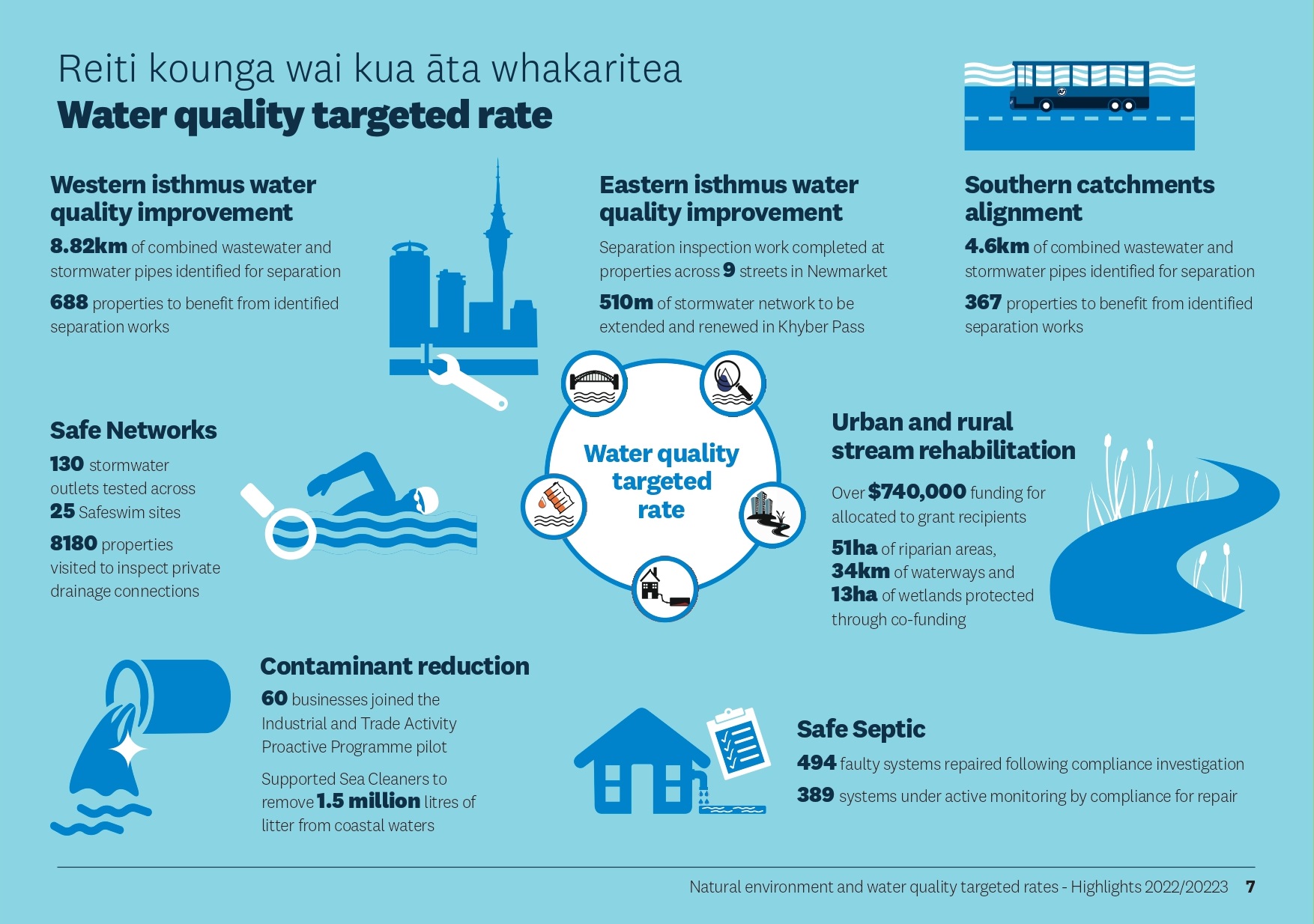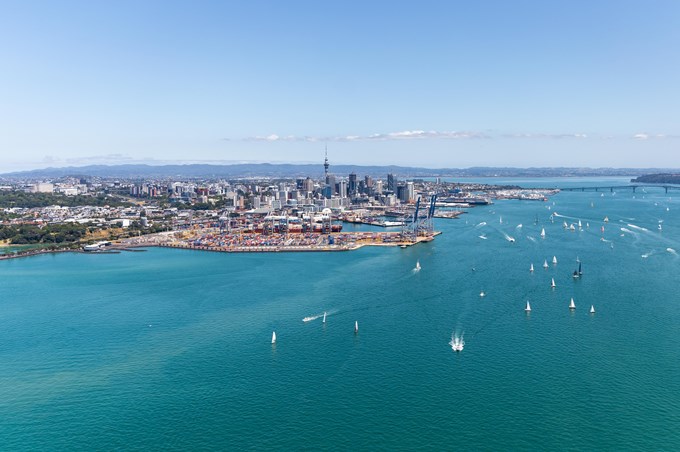In Tāmaki Makaurau, we’ve seen our relationship with water challenged. Two years of drought followed by a year of record rainfall has reminded Aucklanders that we must protect and enhance the quality of our water.
Targeted rates are ring-fenced for the purpose they are collected and Auckland Council’s Water Quality Targeted Rate offers a dedicated programme to protect Auckland’s waterways.
“It’s fantastic to see how our targeted rate investment continued to improve water quality throughout 2022/2023, despite the challenges caused by the severe flooding events we experienced this year,” says Councillor Richard Hills, Chair of the Planning, Environment and Parks Committee.
“We know Aucklanders place a high value on our waterways which is why, through this targeted rate, we have committed $452 million on water infrastructure to clean up our beaches, harbours and waterways, from large infrastructure projects to operational programmes like Safe Networks, it’s all making a difference.
“Additional funding from the Recovery Budget 2021-2031 has allowed us to start work on two new programmes which will help to resolve long-term water quality issues in the Eastern Isthmus and Manukau Harbour.”
Another very recent example of the vulnerability of our networks – but also where planned improvements funded through the water quality targeted rate will offer mitigation – is the sinkhole that developed in Parnell and the major impacts that followed. Ngāti Whātua Ōrākei placed a rāhui over the Waitematā Harbour and Watercare activated black pins on Safeswim when the Ōrākei main sewer blocked and significant discharges affected the harbour on 27 September.
Since then, Watercare has built a bypass pipe and pump station to divert flows around the blockage. Auckland Council continue to test the water quality to ensure this taonga is protected and restored.
Key highlights and successes for 2022/2023, for this targeted rate as well as the natural environment targeted rate, were recently presented to the Planning, Environment and Parks Committee.
“We’re now in year five of the water quality targeted rate and we’ve seen some real progress on major projects this past year, demonstrating the impact of targeted rates,” says Councillor Angela Dalton, Chair of the Planning, Environment and Parks Committee.
“We began working on extending the Central Interceptor tunnel from Grey Lynn to Pt Erin Park, adding a further 1.4km to the 14.7km tunnel, which will substantially improve water quality for Herne Bay, St Marys Bay, and our northern beaches.
“We also continued our focus on improving the recreational and swimming environment for Aucklanders, with investigations for drainage issues reaching over 8,000 properties, including the testing of 130 stormwater outlets across 25 beaches.”
Water quality targeted rate
Water quality across Auckland has been affected by storm events through 2023, most significantly by wastewater overflows caused by flooding and debris being washed into waterways. The work delivered by the water quality targeted rate (WQTR) programmes so far has given us the tools and knowledge to support this recovery for stream rehabilitation and will be an ongoing focus in future work programmes.

Key highlights and successes for 2022/2023
The water quality targeted rate provides increased investment for projects that will result in cleaner harbours, beaches, and streams. Our key priorities are to reduce public health risks from wastewater and to improve the health of our waterways. Through several key work programmes, our team is working hard to achieve these outcomes.
What has been achieved with the water quality targeted rate?
Western isthmus water quality improvement programme
We’re building major infrastructure to reduce public health risk in this $680 million programme, which is jointly funded by the targeted rate and Watercare.
It fast-tracks major infrastructure upgrades to significantly reduce wastewater overflows into the Waitematā Harbour and reduce stormwater entering the wastewater network. The project will stop wet weather wastewater overflows during most normal rainfall events and make all beaches from Pt Chevalier to St Marys Bay swimmable under most conditions.
A key outcome for 2022/2023 was the decision to extend the Central Interceptor tunnel from Grey Lynn to Pt Erin Park as well as the associated design and consenting work that was undertaken.
Safe Networks
This programme investigates and fixes drainage network issues that contribute to poor water quality and pose a risk to public health at our beaches and waterways. Where contaminants are found, indicating the presence of wastewater, our teams will investigate, track and monitor discharges to their point of origin through water quality sampling, CCTV, and smoke and dye testing. Once the source is identified, we will either mitigate the discharge or develop solutions if the problem is more complex.
This year, our teams tested 130 stormwater outlets across 25 beaches and began a further 14 network investigations, as well as inspected private property drainage at over 8,000 properties.
Safe septic
Regular maintenance of the region’s 45,000 private onsite wastewater systems is essential for reducing faecal contaminants entering our waterways and beaches.
We are implementing a region-wide compliance system requiring property owners with onsite wastewater systems to provide regular maintenance records showing their systems are in good working condition.
Urban and rural stream rehabilitation
This programme’s key objective is to improve the ecological health of our streams and rivers. This involves managing streambank erosion, as well as working with the community to replant and revive our streams.
Contaminant reduction
We are improving the ecological health of waterways – both in urban and rural areas.
Urban areas contribute contaminants from transport, industrial use, litter, and construction to our waterways. Stormwater networks in older parts of Tāmaki Makaurau were previously mostly designed to move rather than treat water. Our targeted retrofit programme identifies opportunities to improve water quality treatment in our existing stormwater networks.
In rural areas, our support of the Kaipara Moana Remediation programme enables coordinated planning and problem solving to deliver large-scale projects that restore the health and mauri of the Kaipara Moana by reducing sediment contamination.
Eastern isthmus water quality improvement
Following the progress made in the western isthmus programme, the council has invested $174 million in this programme within the current 10-year budget. The eastern isthmus has significant water quality issues affecting coastal environments from the central city to the Tāmaki Estuary. Like the Western Isthmus programme, investment in stormwater infrastructure is necessary to complement Watercare’s investment in the wastewater network to reduce overflows and pollution. This involves building stormwater infrastructure to enable sewer separation and stormwater treatment.
Southern catchment alignment
This new programme was introduced in the 10-year Budget 2021-2031 to improve water quality in the Manukau Harbour by aligning the timing of stormwater improvements with other major infrastructure projects.
As significant work is expected to begin from 2026, this past year we focussed on identifying opportunities for projects where we could implement water quality improvements alongside scheduled infrastructure improvements. This is so we could minimise disruptions, maximise efficiencies and achieve better water quality outcomes.


